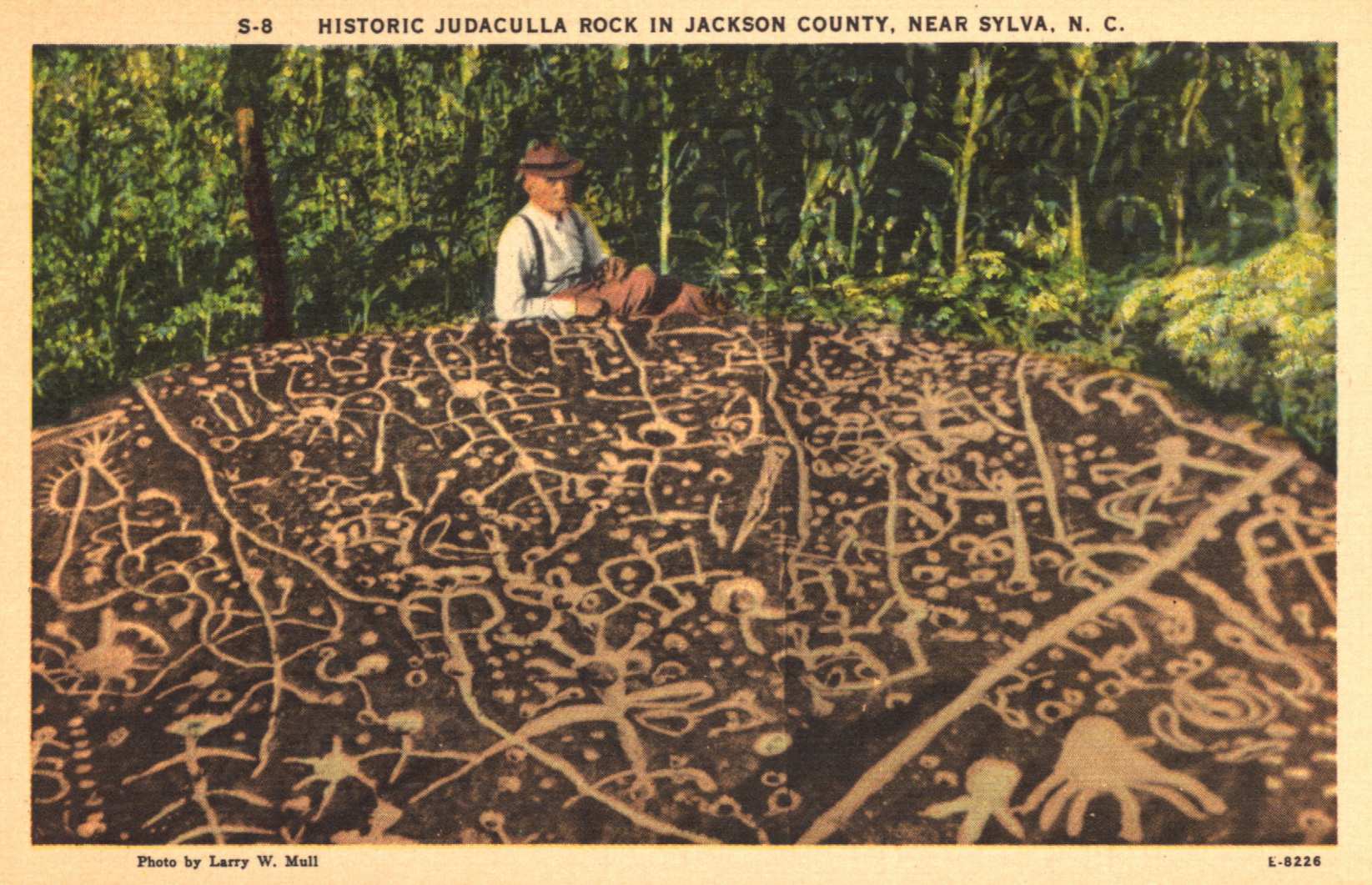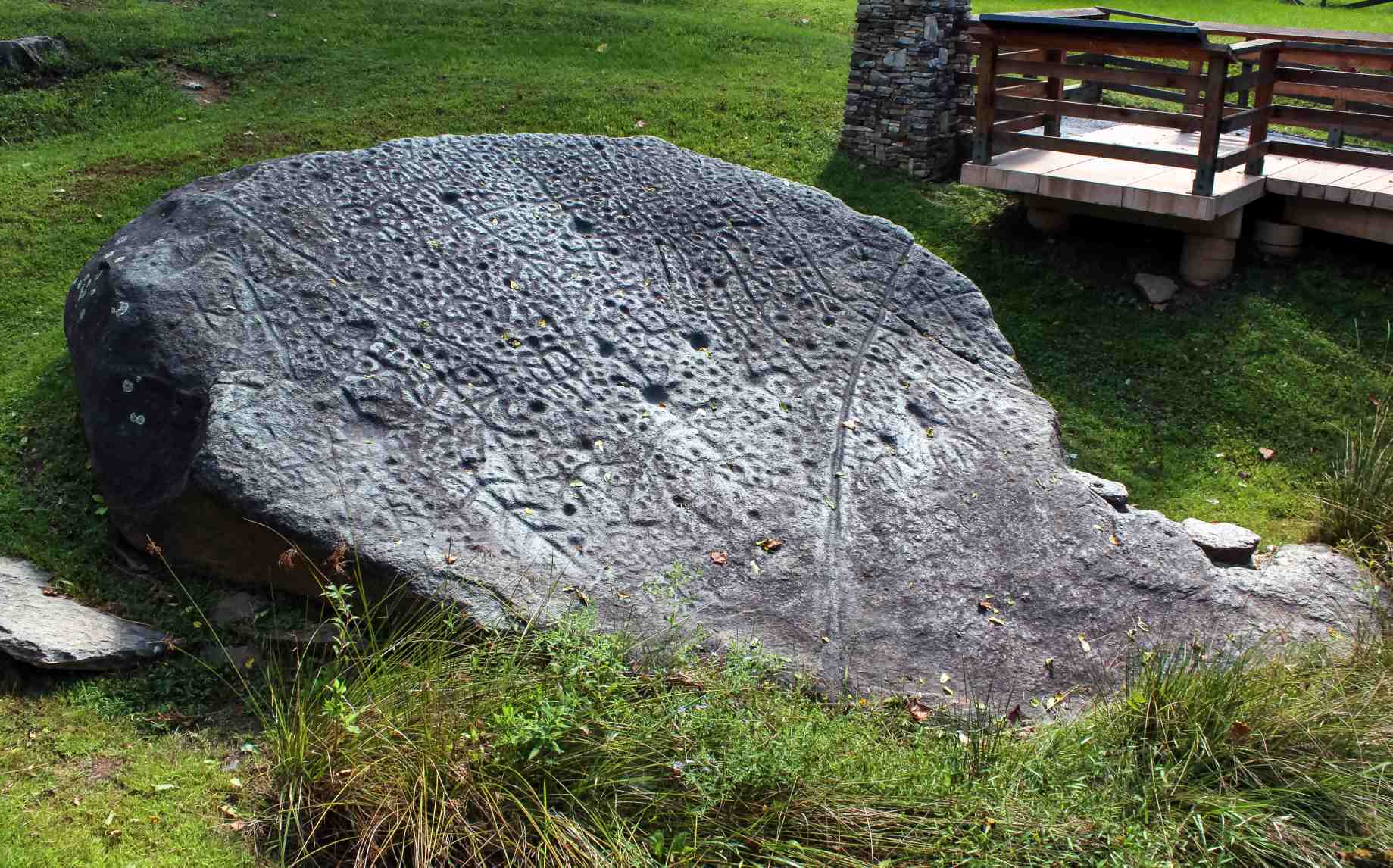Nestled in the heart of the Blue Ridge Mountains stands a mysterious rock with enigmatic carvings that have puzzled historians and archaeologists for centuries. Known as the Judaculla Rock, this ancient artifact holds a special place in Cherokee history and legend. Many have attempted to decipher its meaning and purpose, but the true story behind the rock remains shrouded in mystery.

One of the most intriguing legends associated with the Judaculla Rock is that of the Slant-Eyed Giant, a mythical creature said to have once roamed the mountains and left its mark on the rock. Join us as we delve into the fascinating history and legends of the Judaculla Rock, and uncover the secrets of this ancient relic that has captivated the minds of so many for generations.
The Judaculla Rock

The Judaculla Rock is a large soapstone boulder located in Jackson County, North Carolina, that is covered in mysterious symbols and carvings – more than 1,500 petroglyphs all over it. It is considered one of the most significant Native American rock art sites in the Southeastern United States. The rock, which is estimated to be around 3,000 years old (some even date back to between 2000 and 3000 BC), is named after the Cherokee legend of the Slant-Eyed Giant, also known as Tsul ‘Kalu.
The legend of the Slant-Eyed Giant – Tsul ‘Kalu in Cherokee mythology
According to Cherokee mythology, Tsul ‘Kalu was a powerful giant who lived in the mountains and was feared by the people. He had slanted eyes and was covered in hair from head to toe. Though little is known about this giant humanoid creature, but legend has it he self-conscious and became very angry when people talked badly about his physical appearance. Tsul ‘Kalu avoided people and remained hidden in the mountain. He used to come out late in the evening or at night when he knew people were indoors.
It was said that he could control the weather and cause earthquakes. However, Tsul ‘Kalu was not evil, and he helped the Cherokee people on many occasions, including teaching them how to hunt, fish, and farm. When he died, his spirit was said to have entered the Judaculla Rock, which then became a sacred site for the Cherokee people. The Cherokee say it was the slant-eyed giant who left the markings on the soapstone. As legend describes, he scratched the rock with his 7 fingered hands. Others say he worked with his toes while scratching.
The Cherokee believed that Judaculla was able to take ordinary people to the spirit world and was able to communicate with people. It appears to be a similar type of god-like creature as the ones mentioned in all mythologies around the world.
History and significance of the Judaculla Rock
The Judaculla Rock was first discovered by European settlers in the 1800s, but it was already a sacred site for the Cherokee people. The rock is covered in hundreds of symbols and carvings that have been interpreted in various ways. Some believe that the symbols represent hunting scenes, while others think they may be astronomical or religious symbols. The rock is also significant because it provides a glimpse into the lives and beliefs of the Cherokee people before European contact.
Interpretations and meanings of the Rock’s enigmatic symbols
The symbols on the Judaculla Rock have been the subject of much debate and interpretation. Some researchers believe that they represent hunting scenes, with images of deer, bear, and other animals. Others think that the symbols may be astronomical in nature, representing constellations or celestial events. Some have even suggested that the symbols may have religious or spiritual significance, representing the Cherokee’s relationship with the natural world.
Studies and research on the Judaculla Rock
Since the Judaculla Rock’s discovery, it has been the subject of numerous studies and research projects. Archaeologists and historians have attempted to decipher the symbols and understand their meaning, as well as learn more about the Cherokee culture and history. In recent years, advanced technology, such as 3D laser scanning, has been used to create detailed images of the rock, which has helped researchers better understand the symbols and carvings.
Preservation and conservation of the Judaculla Rock
The Judaculla Rock is an important cultural and historical site that must be preserved and protected for future generations. The rock is on public land, and efforts have been made to limit access and protect it from vandalism and damage. The Eastern Band of Cherokee Indians and the North Carolina State Historic Preservation Office have worked together to develop a management plan for the site, which includes regular monitoring and maintenance.
Visiting the Judaculla Rock – tips and guidelines
If you are interested in visiting the Judaculla Rock, there are a few things to keep in mind. The site is on public land, but visitors are asked to respect the area and not touch or climb on the rock. There is a small parking area nearby, and a short trail leads to the rock. Visitors should also be aware that the site is sacred to the Cherokee people, and should be treated with respect and reverence.
Other legends and stories in Cherokee mythology
The Cherokee people have a rich and fascinating mythology, with many legends and stories that have been passed down through generations. In addition to the legend of Tsul ‘Kalu and the Judaculla Rock, there are many other stories that provide insight into Cherokee culture and history. These stories include tales of spiritele animale, the first fire, the pheasant beating corn, mituri ale creației, the eagle’s revenge and legends of heroes and villains.
The legacy of the Judaculla Rock in Cherokee culture and heritage
The Judaculla Rock is an important part of Cherokee culture and heritage, and its significance continues to be felt today. The rock serves as a reminder of the Cherokee people’s deep connection to the land and their spiritual beliefs. It also provides a glimpse into their way of life before European contact. The rock’s legacy is celebrated by the Cherokee people, who consider it a sacred site and an important part of their cultural heritage.
Cuvintele finale
The Judaculla Rock is a fascinating and enigmatic site that continues to captivate researchers and visitors alike. Its symbols and carvings have been interpreted in many ways, and its significance to the Cherokee people is undeniable. As we continue to learn more about the rock and its history, we gain a deeper understanding of Cherokee culture and heritage. If you have the opportunity to visit the Judaculla Rock, take the time to appreciate its beauty and significance, and remember the legacy of the Slant-Eyed Giant and the Cherokee people.
Dacă doriţi să learn more about Cherokee culture and history, consider visiting other important sites in the region, such as the Oconaluftee Indian Village or the Museum of the Cherokee Indian. These sites provide a glimpse into the rich and fascinating history of the Cherokee people.




